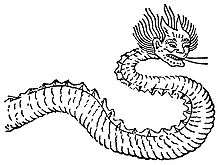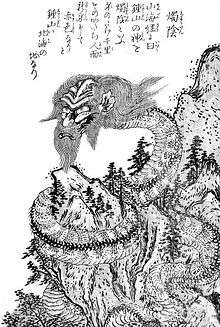Zhulong (mythology)


Zhulong (Chinese: 燭龍; pinyin: zhúlóng; Wade–Giles: chu-lung; literally: "torch dragon") or Zhuyin (Chinese: 燭陰; pinyin: zhúyīn; Wade–Giles: chu-yin; literally: "illuminating darkness", or "Torch Shadow") was a giant red draconic solar deity in Chinese mythology. It supposedly had a human's face and snake's body, created day and night by opening and closing its eyes, and created seasonal winds by breathing.
Names
The keyword in the names Zhuyin and Zhulong is zhu 燭 (simplified 烛) "torch; candle; shine upon; illuminate; light up" (cf. zhuo 灼 "burn; illuminate; bright"). One alternate Chuci name below writes zhu with the variant Chinese character zhuo 逴 or 趠 "quarrel, squabble; distant, far".
Zhuyin uses zhu as a verb "illuminate; brighten" with yin 陰 (simplified 阴) "dark; shady; cloudy; overcast", which is the feminine principle of Yin and Yang. Yin recurs below in the term jiuyin 九陰 "ninefold darkness".
Zhulong uses zhu as a modifier "torch; candle" with long 龍 (simplified 龙) "Chinese dragon". Compare the homophone zhulong 燭籠 "lantern" with long 籠 "basket; cage; receptacle".
Early textual references
Zhuyin and Zhulong were first recorded in Chinese classic texts dating from the Han Dynasty (206 BCE-220 CE) and recording myths from the Zhou Dynasty (1122 BCE-256 BCE).
Shanhaijing
The (ca. 3rd century BCE-1st century CE ) Shanhaijing "Classic of the Mountains and Seas" records parallel myths about Zhuyin and Zhulong.
"The Classic of Regions Beyond the Seas: The North" section (8) describes Zhuyin 燭陰 on Mount Zhong 鍾山.
The deity of Mount Bell is named Torch Shade. When this deity's eyes look out there is daylight, and when he shuts his eyes there is night. When he blows it is winter, and when he calls out it is summer. He neither drinks, nor eats, nor breathes. If this god does breathe, there are gales. His body is a thousand leagues long. Torch Shade is east of the country of Nolegcalf. He has a human face and a snake's body, and he is scarlet in colour. The god lives on the lower slopes of Mount Bell. (tr. Birrell 2000:121)
Visser (1913:62-3) renders Zhuyin as "Enlightener of the Darkness" and translates the commentary of Guo Pu (276-324 CE).
'Enlightener' is a dragon; he enlightens the nine yin (darknesses, i.e. the nine points of the compass at the opposite, dark side of the earth, which is a flat disk; these nine points are North, South, East, West, North-east, North-west, South-east, South-west, and the Centre)". (tr. Visser 1913:62)
"The Classic of the Great Wilderness: The North" section (17) describes Zhulong 燭龍 living on Mount Zhangwei 章尾山.
Beyond the northwest seas, north of the River Scarlet there is Mount Brillianttail. There is a god-human here with a human face and a snake's body, and he is scarlet. He has vertical eyes that are in a straight seam. When this deity closes his eyes, there is darkness. When the deity look with his eyes, there is light. He neither eats, nor sleeps, nor breathes. The wind and the rain are at his beck and call. This deity shines his torch over the ninefold darkness. This deity is Torch Dragon. (tr. Birrell 2000:188)
The yin in this jiuyin 九陰 "ninefold darkness" context explains using the "dragon" name Zhulong instead of "darkness" name Zhuyin. Guo Pu quotes a legend from a no longer extant Shijing commentary (tr. Major 1993:204), "The sky is insufficient to cover the northwest, so there is no ebb and flow of yang and yin. Therefore a dragon carries a torch in its mouth to light up the sky."
Chuci
The (3rd-2nd centuries BCE) Chuci "Songs of Chu" mentions Zhulong 燭龍 and Zhuolong 逴龍 with the graphic variant zhuo or chuo "argue, quarrel, squabble; far".
The Tianwen 天問 "Heavenly Questions" section (3, cf. Bashe) asks about Zhulong. Compare these translations:
- "What land does the sun not shine on and how does the Torch Dragon light it?" (Hawkes 1985:128)
- "Where does the sun not rise, How does the Torch Dragon flame?" (Field 1986:44)
- "The Torch Dragon flares where the sun does not reach [where? how?]" (Major 1993:203)
The Dazhao 大招 "Great Summons" section (10, tr. Hawkes 1985:234) uses the alternate name Zhuolong 逴龍 or 趠龍 "distant/quarreling dragon": "In the north are the Frozen Mountain, and the Torch Dragon, glaring red."
Huainanzi
The (2nd century BCE) Huainanzi "Philosophers of Huainan" contains a Zhuixing 墬形訓 "Treatise on Topography" chapter (4) that refers to Zhulong. This context mentions Xiaoming 宵明 "Night Bright" and Zhuguang 燭光 "Torch Gleam", who were daughters of the legendary Shun.
Lighting Darkness and Candle-Gleam are on an island in the Yellow River; they illumine an area of one thousand li. The Dragon Gate is in the depths of the Yellow River. … The Torch Dragon dwells north of Wild Goose Gate. He hides himself in Abandoned Wings Mountain and never sees the sun. This god has a human face and a dragon body, but no feet. (tr. Major 1993:196)
The commentary of Gao You 高誘 (ca. 168-212 CE, tr. Major 1993:163) explains, "Weiyu is the name of a mountain … in the shade of the northern limit, the sun cannot be seen." Mount Weiyu 委羽, notes Major, might mean "abandoned wings," "broken wings," "shed feathers," or something else.
Dongmingji
The Dongmingji 洞冥記 "Record of Penetrating the Mysteries", which describes ritual activities of Emperor Wu of Han (r. 141-87 BCE), is traditionally attributed to Guo Xian 郭憲 (fl. 25-57 CE) but probably dates (Smith 2008:368) from around the 6th century. Although this text does not mention Zhuyin or Zhulong, Wu's Daoist advisor Dongfang Shuo describes a mythical northern qinglong 青龍 "Azure Dragon" with a zhu 燭 "torch".
… in the year 99 before our era the emperor Wu convoked a meeting of magicians and learned men, at which Tung Fang-soh spoke as follows: "I made a journey to the north pole, and came to a mountain planted with fire, which neither the sun, nor the moon ever illumines, but which is lighted to its uttermost bounds by a blue dragon by means of a torch which it holds in its jaws. I found in that mountain gardens, fields, and parks with ponds, all studded with strange trees and curious plants, and with shrubs which had luminiferous stalks, seeming at night to be lamps of gold. These stalks could be broken off and used as torches, in the light of which the spectres were visible. Ning-fung, the immortal had always eaten this plant, the consequence being that in the darkness of the night there beamed light out of his belly. It is called the herb which pierces darkness. (tr. Groot 1910 6:1167)
This namesake torch-like plant is called dongmingcao 洞冥草 "penetrating the mysteries herb".
Interpretations
Zhuyin 燭陰 or Zhulong 燭龍 was not the only serpent-bodied celestial deity in Chinese folklore, other examples include Pangu, Fuxi, and Nüwa.
The mythic Torch Dragon embodied sunlight. Carr (1990:155) cites a Chinese-language article by Kwang-chih Chang characterizing it with the Eastern Zhou "Transformation Thesis" that natural elements transform out of the bodily parts of mythical creatures.
Major (1993:203-4) describes the Torch Dragon as "well-known in early Chinese mythology" and suggests it is probably "a mythical interpretation of the aurora borealis."
References
- Birrell, Anne, tr. 2000. The Classic of Mountains and Seas. Penguin.
- Carr, Michael. 1990. "Chinese Dragon Names", Linguistics of the Tibeto-Burman Area 13.2:87-189.
- Eberhard, Wolfram. 1968. The Local Cultures of South and East China. E. J. Brill.
- Field, Stephen, tr. 1986. Tian Wen, A Chinese Book of Origins. New Directions.
- Groot, J.J.M. de. 1910. The Religious System of China 6. E. J. Brill.
- Hawkes, David, tr. 1985. The Songs of the South: An Anthology of Ancient Chinese Poems by Qu Yuan and Other Poets. Penguin.
- Major, John S. 1993. Heaven and Earth in Early Han Thought: Chapters Three, Four, and Five of the Huainanzi. SUNY Press.
- Smith, Thomas E. 2008. "Dongming ji 洞冥記 Records of Penetration into the Mysteries", in The Encyclopedia of Taoism, ed. Fabrizio Pregadio, Routledge, 367-368.
- Visser, Marinus Willern de. 1913. The Dragon in China and Japan. J. Müller.
External links
- Zhú Lóng – The Illuminating Dragon, China History Forum
- 燭龍, 中國上古神話 (Chinese)